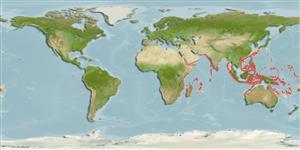Malacostraca |
Decapoda |
Scyllaridae
Environment: milieu / climate zone / depth range / distribution range
Ecology
Benthic; depth range 160 - 484 m (Ref. 4), usually 170 - 210 m (Ref. 4). Tropical; 28°N - 24°S, 32°E - 138°E (Ref. 4)
Indo-West Pacific.
Length at first maturity / Size / Weight / Age
Maturity: Lm ? range ? - ? cm Max length : 7.0 cm CL male/unsexed; (Ref. 4)
It has lengths of 7 cm, maximum total body length; 3 cm (male 1.4 to 2.9 cm; female 1.5 to 3.3 cm; ovigerous female 2.3 to 3.1 cm), carapace length (Ref. 4). Occurs at a depth range from 160 to 484 m, usually between 170 and 210 m, on sandy and muddy substrates (Ref. 4).
Life cycle and mating behavior
Maturity | Reproduction | Spawning | Eggs | Fecundity | Larvae
Members of the order Decapoda are mostly gonochoric. Mating behavior: Precopulatory courtship ritual is common (through olfactory and tactile cues); usually indirect sperm transfer.
Holthuis, L.B. 1991. (Ref. 4)
IUCN Red List Status (Ref. 130435)
CITES status (Ref. 108899)
Not Evaluated
Not Evaluated
Threat to humans
Harmless
Human uses
Fisheries: of no interest
| FishSource |
Tools
More information
Age/SizeGrowthLength-weightLength-lengthMorphologyLarvaeAbundance
Internet sources
Estimates based on models
Preferred temperature
(Ref.
115969): 13.6 - 21.4, mean 15.6 (based on 82 cells).
